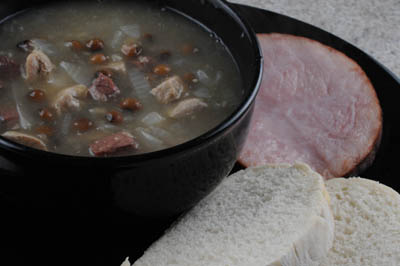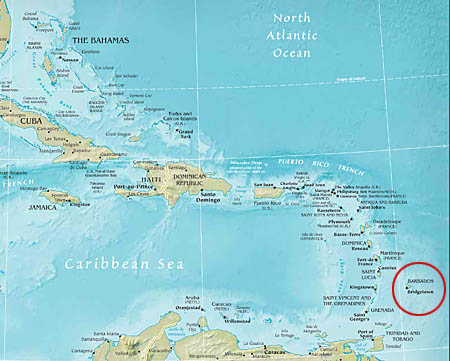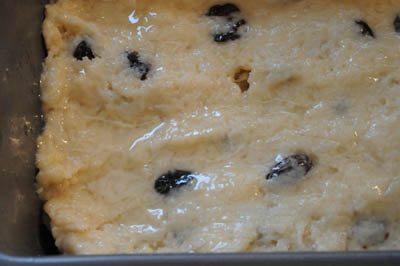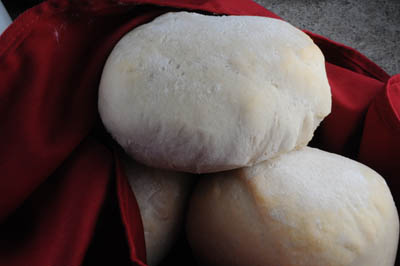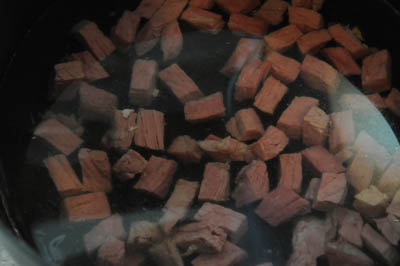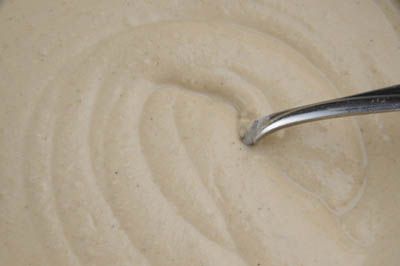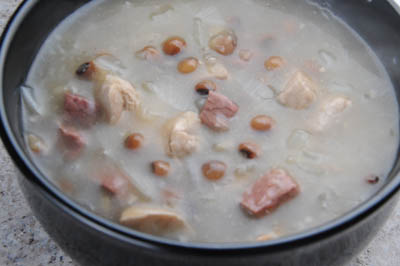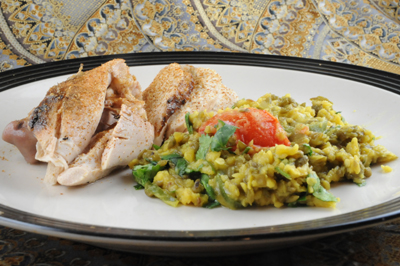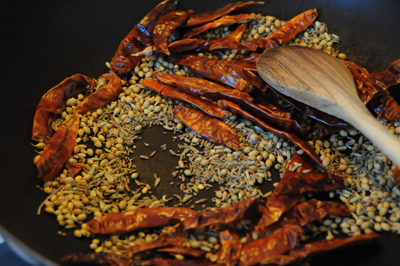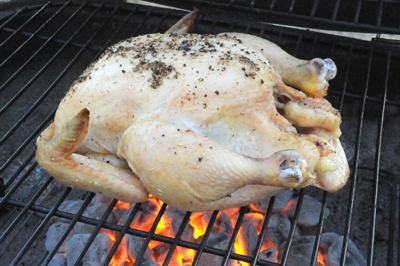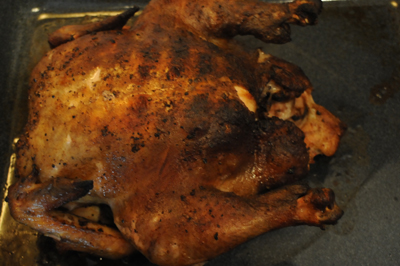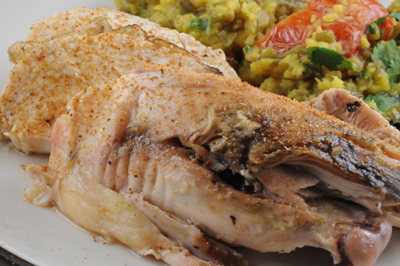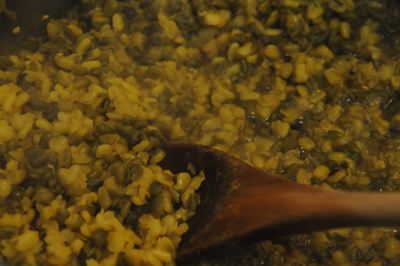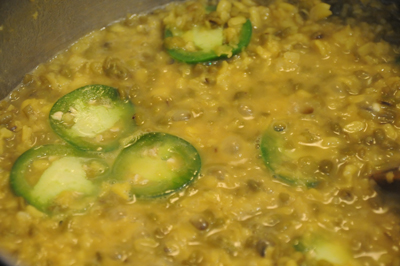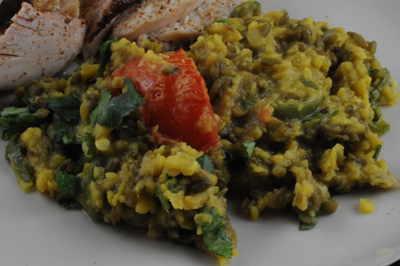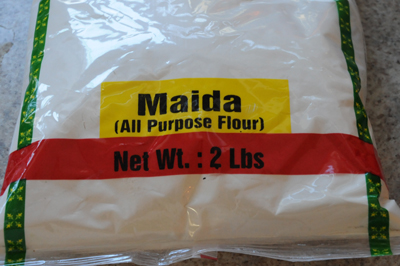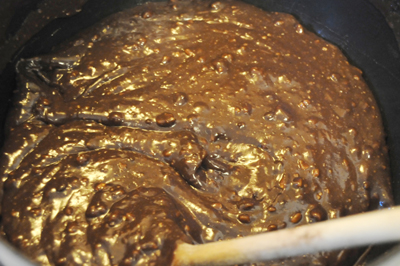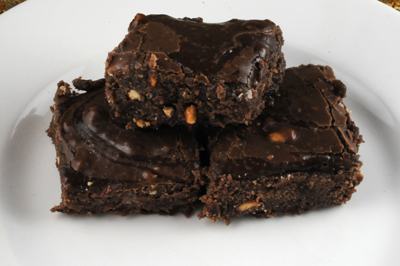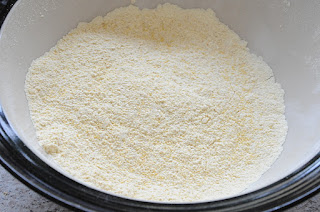I wish I could remember where my list came from, because this is actually the second time a country has shown up that I would really not in any way persoanly call an actual "country." Sure there have been a few odd ones, like Akrotiri, which is really just an RAF base on the island of Cyprus, and Antarctica, which is just a series of research stations on a very cold block of ice that doesn't actually have a government or even belong to any one specific country. But those two places weren't entirely problematic because there are people living there, and people have to eat.
But Ashmore and Cartier was different, because there is no one living there. And neither is there anyone living in our next country, Bassas da India.
But that doesn't mean that Bassas da India has no culinary tradition, because it does.
Bassas da India is a 6 mile diameter circular atoll that includes 10 completely barren rocky islets, a reef with 22 miles of coastline and a shallow lagoon. Contrary to its name, it is not really anywhere near India. It is actually located roughly between Madagascar and Mozambique in the southern Mozambique channel. The name "Bassas da India" stems from a cartography transcription error of the original name, which was "Baixo da Judia," or "Shoal of Judia." The area got this name because one of the many ships that ran aground on its treacherous reef was a Portuguese ship named "Judia."
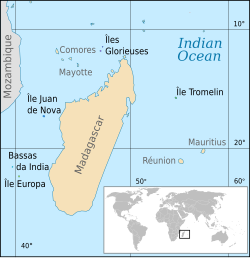 |
| Bassas da India is a small group of islets between Mozambique and Madagascar. |
So how does a country consisting of 10 barren islets and a shallow lagoon have its own culinary tradition? Well as I discovered pretty blissfully early on in my research, Bassas da India is a popular fishing destination, and there are a number of companies that charter boats in the area. And there is always food aboard a chartered boat.
So I started my quest by contacting Fred Steynberg, a fishing enthusiast who has dedicated an entire page of his website to Bassas da India. Fred referred me to Brent Craig of Island Adventure Charters. Brent is the chef on board the Pelagic 2, a boat that takes fishing enthusiasts into Bassas da India in pursuit of Yellowfin Tuna, Wahoo, Barracuda, Giant Kingfish and maybe another couple of dozen other species of fish.
On board the Pelagic 2, Brent serves simple meals made from (what else) fresh fish. He was generous enough to send me two recipes, the first an appetizer (scaled down to serve two people instead of a whole boat):
Sesame Tuna (my name)
- 1 7-ounce sushi-grade yellowfin tuna steak
- Chicken spice to coat (more on that later)
- Sesame seeds to coat
- 1 tbsp olive oil
- 1/2 tsp powdered chicken stock
- Pickled ginger
- Soy sauce (for dipping)
The second a main course:
Tuna Pasta Pelagic Style
- 6 oz dry spaghetti noodles
- 1 tbsp olive oil
- 4 garlic cloves, crushed
- 1 small onion, chopped
- 1 tsp chili powder
- 8 to 10 cherry tomatoes, halved
- 1/3 each red, yellow and orange bell peppers, chopped
- 3/4 lb yellowfin tuna, cut into bite sized pieces
- 1/4 cup soy sauce
- 9 small basil leaves
Now Brent seemed like a busy guy, so I didn't want to bug him too much with questions--which meant a few things about both of these recipes were left open to interpretation. Most things, actually, since I didn't know how many servings each recipe made and there were only a few measurements included in the original versions that Brent sent to me. But because Bassas da India is one of those psuedo-countries, I didn't feel as much pressure the get everything exactly right, so rather than pester Brent I decided to just wing it. Based on my results, I think I did a pretty good job.
Both of these recipes are simple and cook up quickly, which is particularly nice for me since these meals are usually a lot of work. So starting with the appetizer:
Coat the tuna steak with the chicken spice. Now this is really the one major thing I wasn't too sure about: "chicken spice," which could mean poultry seasoning, or it could mean any number of different spice blends on the market that are specifically designed for pairing with chicken. Poultry seasoning seems more to me like an herb blend than an actual "spice," so I decided to pick one of the spice blends instead. The one I chose was Grillmates "Kickin' Chicken," which did give my finished product a little bit of the proverbial "kick."
After coating the tuna with the spice blend, sprinkle both sides with sesame seeds.
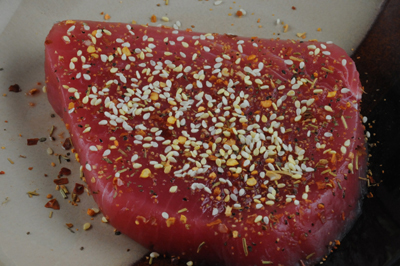 |
| Coat the tuna with the chicken spice and sesame seeds. |
Now heat the oil in a pan. You want it to be pretty hot, since you will be searing the outside of the tuna while keeping it pretty rare in the middle.
As the oil heats up, stir in the powdered chicken stock. Now add the tuna steak and fry lightly on both sides. You only want about a quarter of the meat to actually cook through; the remaining 3/4 on the inside should stay pink.
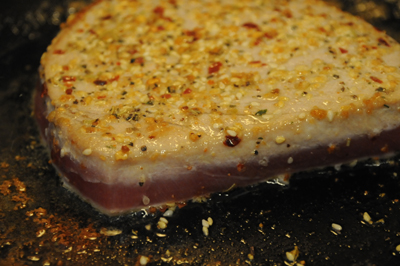 |
| Now lightly fry the tuna. Make sure there is still plenty of pink inside. |
Remove the fish from the heat and slice thinly. Serve with pickled ginger and a small dish of soy sauce for dipping.
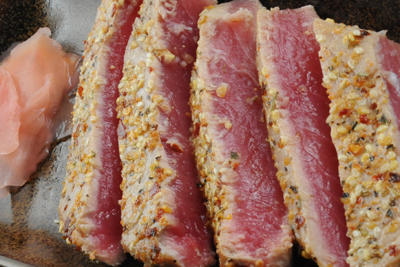 |
| Here's how the finished dish should look--rare, rare, rare. |
Now on to the main course. This meal has a really pretty combination of vegetables, including three different colors of bell pepper and cherry tomatoes.
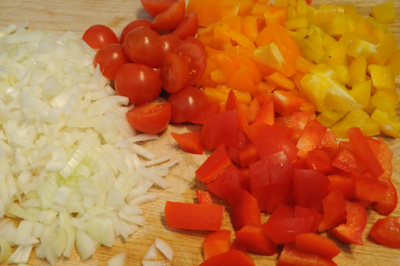 |
| Colorful veggies aren't they? |
First, fry the onion in the oil. Add the chili powder and stir to incorporate.
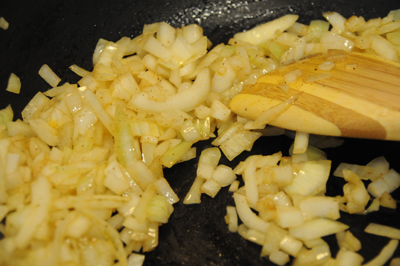 |
| The real question is, just how many frying onion photos can one person have? |
Now add the bell peppers and continue to stir until the vegetables are soft. Add the garlic and cook for a minute or so, then add the halved cherry tomatoes. Meanwhile, boil the pasta according to package directions.
Now put in the tuna chunks and saute until the pink disappears. If the fish looks like it is drying out, add a little olive oil.
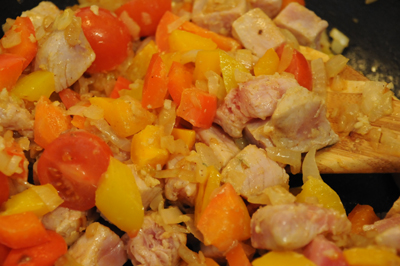 |
| Add the tuna and cook until the pink disappears. This is almost ready. |
Stir in the soy sauce and keep cooking until heated through. Stir in the pasta and garnish each plate with three basil leaves. Serve immediately.
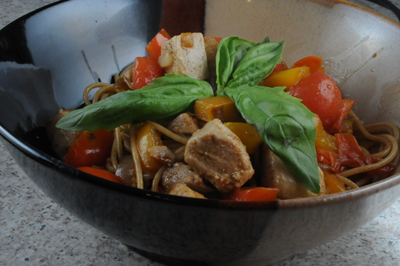 |
| Add basil to garnish. |
Now as you know, I never make my kids eat fish, because frankly it is just a waste of fish. So I made this for Martin and myself after the kids went to bed (they had a mac-n-cheese night).
We are sushi fans, so the tuna appetizer was a really nice treat for us, albeit a bit salty (which made me wonder about my decision to use the Kickin' Chicken instead of a basic poultry seasoning). I also sliced mine a little too thick, but that didn't bother me as much as it did Martin, who prefers a rare tuna to be sliced a bit thinner.
The fish pasta was simple but oh-so-tasty. Martin declared the combination of cherry tomatoes and yellowfin tuna "a stroke of genius." We both loved it.
As much as I enjoy putting together big, complicated, traditional meals, there's something to be said for Gordon Ramsay's mantra of simple recipes with fresh ingredients. This was a fun and challenging menu to come up with, but in preparation it was also a low-stress meal that came out beautifully.
Next week: Belarus
For printable versions of this week's recipes:












